4 April 2024
Do citizens value climate change mitigation over biodiversity? Exploring citizen support for salt marsh conservation and management in Nordic countries - Ocean and Coastal Management
Gaspers A, Banta GT, Veylit L, Vehmaa A, Lanari M, Organo Quintana C, Jensen K, Boström C, Eklöf J, Krause-Jensen D, Leiva-Duenas C, Tiller R.
Salt marshes are highly productive coastal ecosystems relevant for both biodiversity and climate change mitigation but have experienced historical major losses and are among the habitats in need of protection and restoration. Currently, there is little knowledge about how salt marshes are valued from a societal perspective, which has important management implications. This is particularly the case in the Nordic region where awareness of these habitats is low. Using survey data from Norway, Sweden, Finland, Denmark, and Germany, this study contributes understanding how citizens value salt marshes by examining support for different management initiatives framed as contributing to the goal of either biodiversity protection or climate change mitigation. Our study provides guidance for assessment of trade-offs from a human valuation perspective, thus supporting policy makers when considering arguments for salt marsh management within the context of the “30x30” target (protecting and restoring 30% of Earth by 2030) for protected areas.

2 April 2024
Harmonization of Nordic coastal marsh habitat classification benefits conservation and management - Ocean and Coastal Management
Vehmaa A, Lanari M, Jutila H, Mussaari RP, Telenius A, Banta GT, Eklöf J, Jensen K, Krause-Jensen D, Organo Quintana C, von Numers M, Boström, C.
Coastal marshes are productive and diverse habitats that act as essential linkages between marine and terrestrial ecosystems. Although the Nordic region comprises diverse, unique marsh habitats along the Baltic coast and the Atlantic coast of Norway, they are not widely recognized as coastal marshes, e.g., salt marshes in other parts of the world. This may be partly due to inconsistency in habitat classification, use of terminology, and the heterogeneity of these habitats across the region, which limit overviews of their ecology, distribution, and management. Here, we aim to improve the basis for assessments of Nordic coastal marshes by providing an overview of terminology, distribution, area, and management practices of these habitats across the region. Coordinated harmonization of habitat classifications and monitoring across the Nordic countries could increase regional-scale coordination of the management of coastal marshes and facilitate comparative studies.
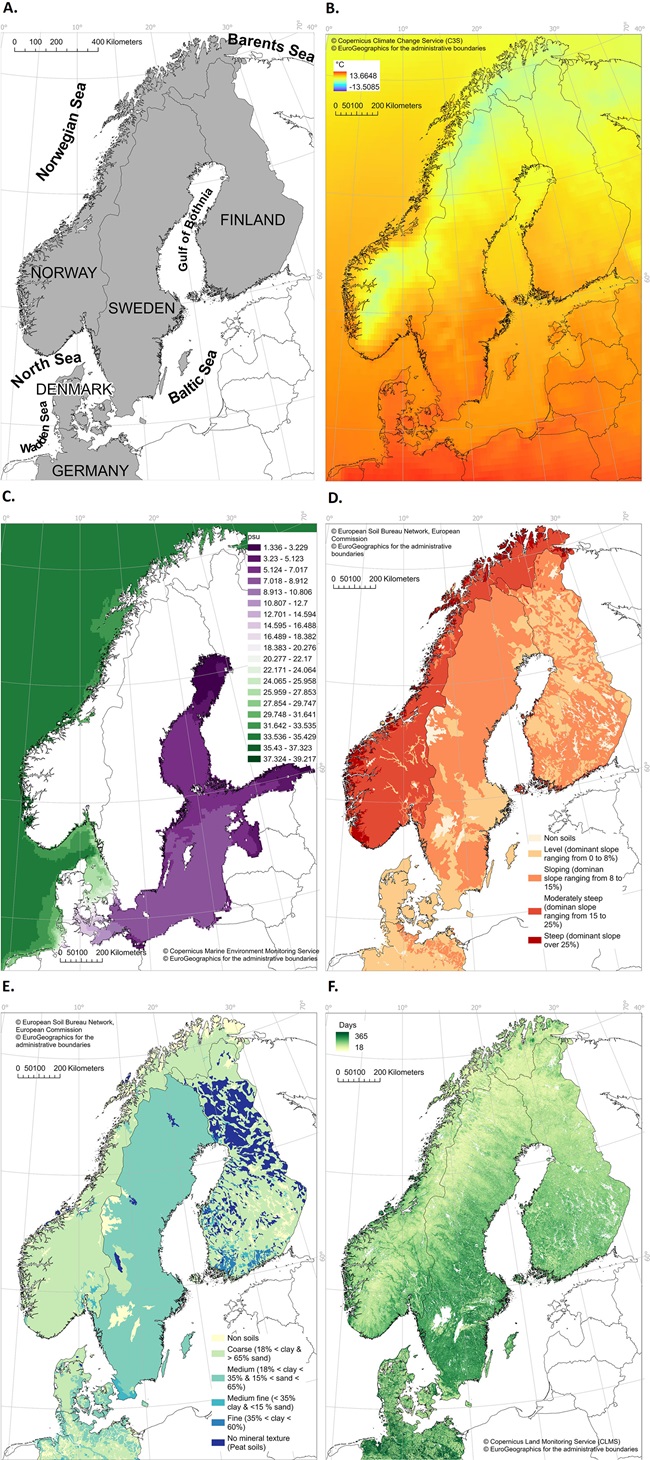
9 January 2024
Region-specific drivers cause low organic carbon stocks and sequestration rates in the saltmarsh soils of southern Scandinavia - Limnology and Oceanography
Leiva-Dueñas C, Graversen AEL, Banta GT, Hansen JN, Schrøter MLK, Masqué P, Holmer M, Krause-Jensen D.
Saltmarshes are known for their ability to act as effective sinks of organic carbon (OC) and their protection and
restoration could potentially slow down the pace of global warming. However, regional estimates of saltmarsh OC
storage are often missing, including for the Nordic region. To address this knowledge gap, we assessed OC storage
and accumulation rates in 17 saltmarshes distributed along the Danish coasts and investigated the main drivers of soil
OC storage. Our research expands the baseline data needed to advance blue carbon research and management in the
Nordic region while highlighting the need for a more comprehensive approach to saltmarsh management that considers
the full range of services of these ecosystems and does not only focus on climate benefits.
Nordic region while highlighting the need for a more comprehensive approach to saltmarsh management that considers
the full range of services of these ecosystems and does not only focus on climate benefits.
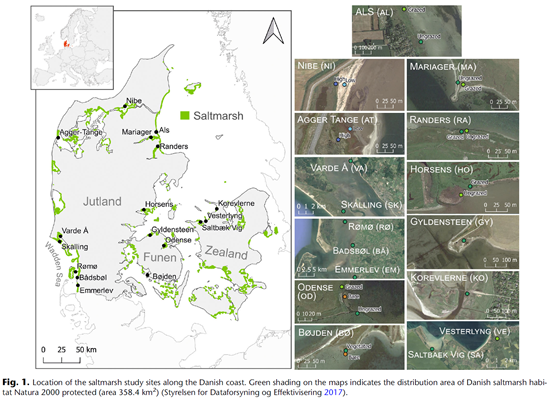
15 March, 2023
Are Nordic Saltmarshes Europe’s Way to ‘Live in Harmony with Nature’? Scientists Driven Future Scenarios via a Participatory Workshop - Environments
Cowan E, Tiller R, and Banta GT
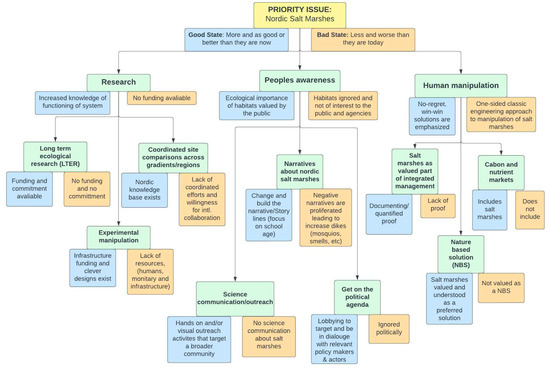
Saltmarshes have the ability to not only promote biodiversity, but to put nations on the path towards climate recovery and net-zero emissions through saltmarshes’ capability to take up carbon. As the European Union’s (EU) Green Deal sets out to reach net-zero emissions by 2050, innovative solutions will need to be identified, possibly even through better preserving century-old habitats such as saltmarshes. Based on the upcoming needs from the EU, in the Spring of 2021, a workshop was held with leading Nordic saltmarsh and blue carbon scientists using the transdisciplinary methods of Systems Thinking and Bayesian Belief Networks to identify solutions that can include saltmarshes in future policy. These joint methods elicited multiple future scenarios in which data were collected on perceived notions of the value of saltmarshes and how to better govern them to ensure their longevity. The models developed in this study include human perceptions and comprehensive quantitative scenarios through their ability to define paths forward in the form of comprehensive policy recommendations. We found through scenario analysis that a major belief among the stakeholders was numerous events of change such as ‘outreach, getting salt marshes on the political agenda and forming new narratives would help to increase saltmarsh area via conservation and restoration prioritization’ would have a positive impact of saltmarshes in Nordic countries.
31 May, 2022
Nordic Blue Carbon Ecosystems: Status and Outlook - Frontiers in Marine Science
Krause-Jensen D, Gundersen H, Björk M, Gullström M, Dahl M, Asplund ME, Boström C, Holmer M, Banta GT, Graversen AE, Pedersen MF, Bekkby T, Frigstad H, Skjellum SF, Thormar J, Gyldenkærne S, Howard J, Pidgeon E, Ragnarsdóttir SB, Mols-Mortensen A, and Hancke K
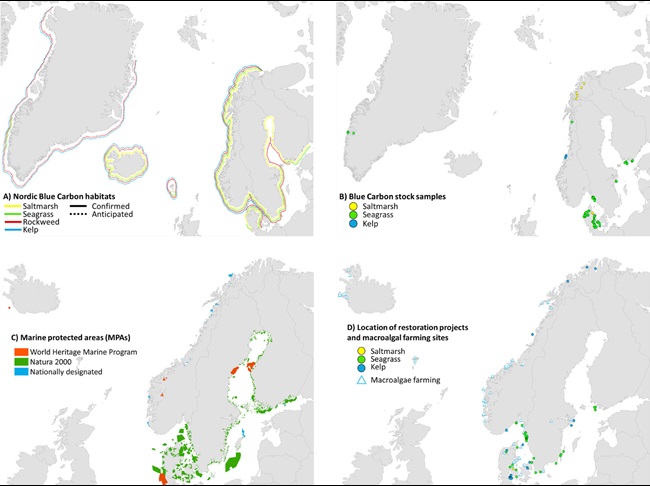
Vegetated coastal and marine habitats in the Nordic region include salt marshes, eelgrass meadows and, in particular, brown macroalgae (kelp forests and rockweed beds). Such habitats contribute to storage of organic carbon (Blue Carbon – BC) and support coastal protection, biodiversity and water quality. Protection and restoration of these habitats therefore have the potential to deliver climate change mitigation and co-benefits. Here we present the existing knowledge on Nordic BC habitats in terms of habitat area, C-stocks and sequestration rates, co-benefits, policies and management status to inspire a coherent Nordic BC roadmap. The area extent of BC habitats in the region is incompletely assessed, but available information sums up to 1,440 km2 salt marshes, 1,861 (potentially 2,735) km2 seagrass meadows, and 16,532 km2 (potentially 130,735 km2, including coarse Greenland estimates) brown macroalgae, yielding a total of 19,833 (potentially 134,910) km2. Saltmarshes and seagrass meadows have experienced major declines over the past century, while macroalgal trends are more diverse. Based on limited salt marsh data, sediment C-stocks average 3,311 g Corg m-2 (top 40-100 cm) and sequestration rates average 142 g Corg m-2 yr-1. Eelgrass C-stocks average 2,414 g Corg m-2 (top 25 cm) and initial data for sequestration rates range 5-33 g Corg m-2, quantified for one Greenland site and one short term restoration. For Nordic brown macroalgae, peer-reviewed estimates of sediment C-stock and sequestration are lacking. Overall, the review reveals substantial Nordic BC-stocks, but highlights that evidence is still insufficient to provide a robust estimate of all Nordic BC-stocks and sequestration rates. Needed are better quantification of habitat area, C-stocks and fluxes, particularly for macroalgae, as well as identification of target areas for BC management. The review also points to directives and regulations protecting Nordic marine vegetation, and local restoration initiatives with potential to increase C-sequestration but underlines that increased coordination at national and Nordic scales and across sectors is needed. We propose a Nordic BC roadmap for science and management to maximize the potential of BC habitats to mitigate climate change and support coastal protection, biodiversity and additional ecosystem functions.
11 January, 2022
Carbon sequestration is not inhibited by livestock grazing in Danish salt marshes - Limnology and Oceanography
Graversen AE, Banta GT, Masque P, and Krause-Jensen D
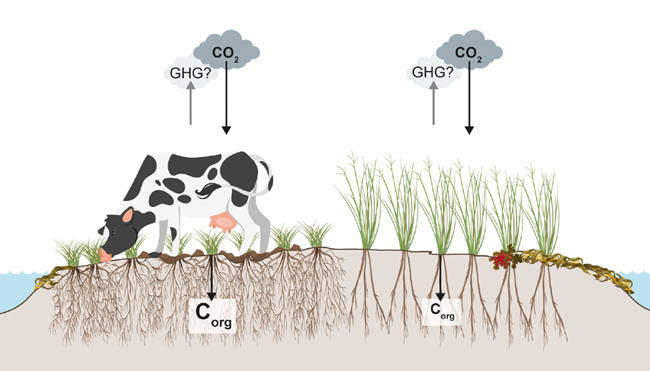
22 June, 2021
Salt Marshes as Climate Buffers (in Danish) - Aktuel Naturvidenskab
Hansen JN, Graversen AE, Krause-Jensen D, and Banta, GT
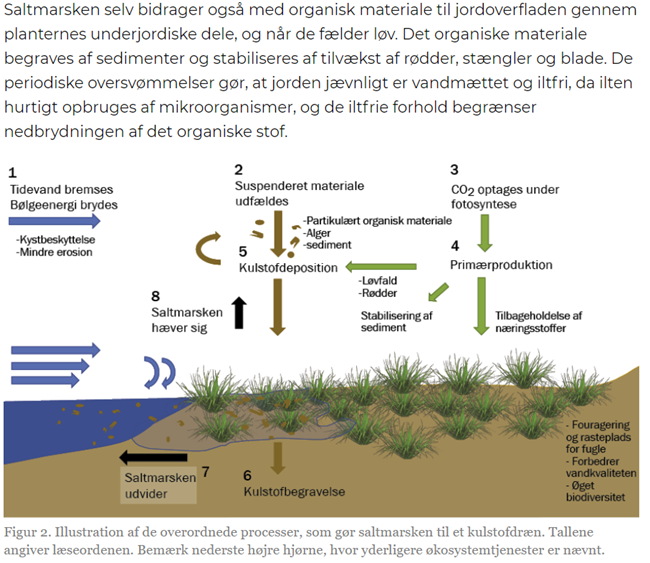
Supporting Literature:
Henriette Selck, Peter B. Adamsen, Thomas Backhaus, Gary T. Banta, Peter K.H . Bruce, G. Allen Burton Jr., Michael B. Butts, Eva Boegh, John J. Clague, Khuong Van Dinh, Neelke Doorn, Jonas S. Gunnarsson, Henrik Hauggaard-Nielsen, Charles Hazlerigg, Agnieszka D. Hunka, John Jensen, Yan Lin, Susana Loureiro, Simona Miraglia, Wayne R. Munns Jr. Farrokh Nadim, Annemette Palmqvist, Robert A. Rämö, Lauren Paige Seaby, Kristian Syberg, Stine R. Tangaa, Amalie Thit, Ronja Windfeld, Maciej Zalewski, Peter M. Chapman (2017). Assessing and Managing Multiple Risks in a Changing World–the Roskilde Recommendations: